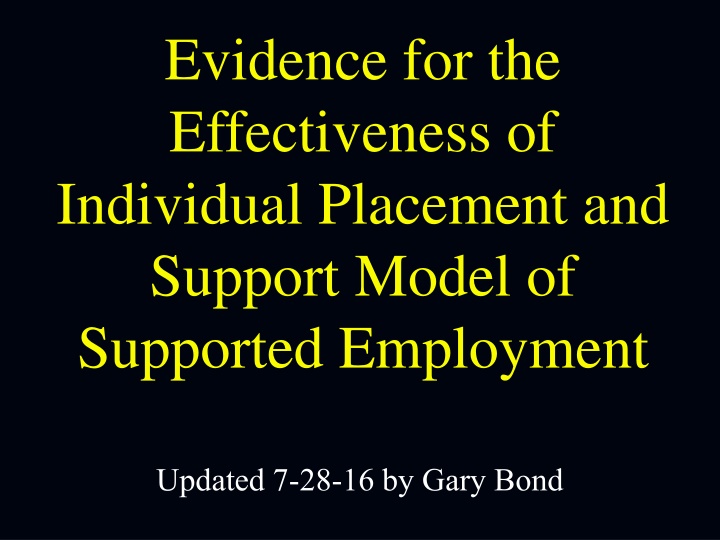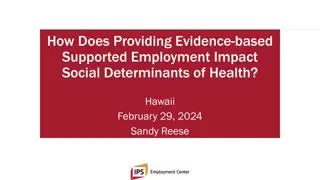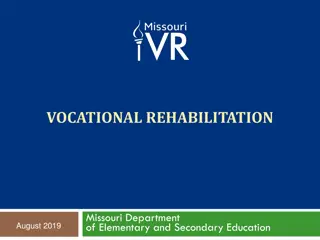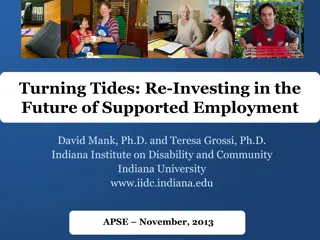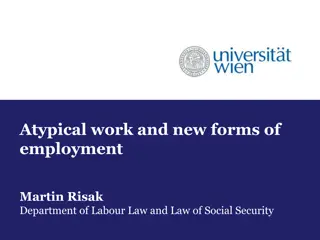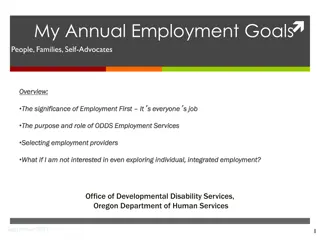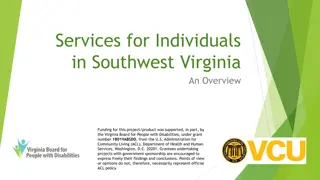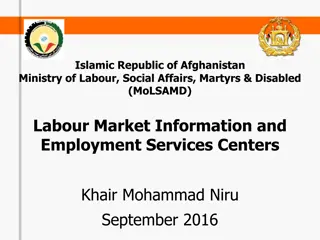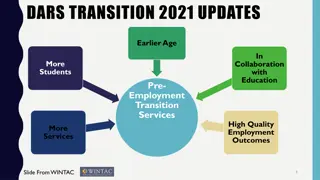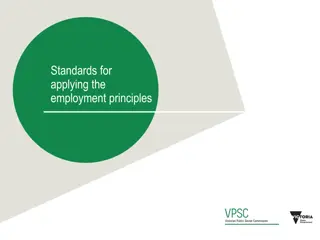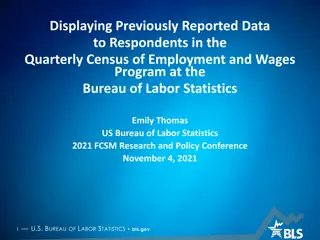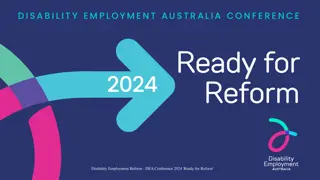Effectiveness of Supported Employment Model
This update discusses the importance of work in recovery, the prevalence of interest in employment among clients, the role of work in the recovery process, the need for Individual Placement and Support (IPS) for clients with severe mental illness, and trends in IPS research.
Download Presentation

Please find below an Image/Link to download the presentation.
The content on the website is provided AS IS for your information and personal use only. It may not be sold, licensed, or shared on other websites without obtaining consent from the author.If you encounter any issues during the download, it is possible that the publisher has removed the file from their server.
You are allowed to download the files provided on this website for personal or commercial use, subject to the condition that they are used lawfully. All files are the property of their respective owners.
The content on the website is provided AS IS for your information and personal use only. It may not be sold, licensed, or shared on other websites without obtaining consent from the author.
E N D
Presentation Transcript
Evidence for the Effectiveness of Individual Placement and Support Model of Supported Employment Updated 7-28-16 by Gary Bond
Why Focus on Work? Most clients want to work! Most clients see work as an essential part of recovery Being productive = Basic human need In most societies, typical adult role Working can be a way out of poverty Working may prevent entry into disability system
Expressed Interest in Employment Reported in 10 Surveys
From a young person who attends a psychosocial rehab (PSR) program: I want to work because it is the only way I will not be in this program when I am old. People don t want to retire from PSR!!
Role of Work in Recovery Process: Work is the best treatment we have
Need for IPS 2/3 clients with severe mental illness want to work, but only ~15% employed. Until the 1990s, no effective models for helping clients achieve stable competitive employment. Even today, only 2% of people who could benefit have access to effective employment services
Four Trends in IPS Research Expanding the evidence base Assessing applicability of IPS for target subgroups Extending IPS to groups beyond people with severe mental illness Developing strategies to disseminate, implement, sustain, and expand IPS
1. Expanding the evidence base Number of studies showing IPS effectiveness continues to grow Long-term outcomes are more positive than previously known IPS produces a good return on investment Steady employment promotes improvement in other life domains
Day Treatment Conversions to IPS: Common Study Design Discontinued day treatment Reassigned day treatment staff to new positions Implemented new IPS program Compared to 3 sites not converting Sources: Drake and Becker
Day Treatment Conversion Studies: 6 Sites Converting to IPS vs. 4 Control Sites (Not Converting) 37.5% 40% 35% 30% 25% Percentage Competitively Employed Before After 20% 15.2% 13.4% 12.4% 15% 10% 5% 0% Sites Converting to IPS (n = 317) Control Sites (n = 184)
Similar Results in All Day Treatment Conversions Large increase in employment rates No negative outcomes (e.g., relapses) Clients, families, staff liked change Most former day treatment clients spent more time in community, even those not working Resulted in cost savings
23 Randomized Controlled Trials of Individual Placement and Support (IPS) Best evidence available on effectiveness RCTs are gold standard in medical research (Drake et al., 2016)
Months Follow- up First Author/ Year Published N (IPS) N (Ctl)Study Population & Salient Eligibility Criteria Study Site Location Control Condition Drake 1996 Manchester & Concord, NH Skills training, nonintegrated 18 73 67 CMHC clients Drake 1999 Washington, DC Enhanced Vocational Rehab 18 74 76 Case management program clients Lehman 2002 Baltimore, MD PSR 24 113 106 CMHC clients, including those without voc goals Mueser 2004 Hartford, CT (1) Brokered SE; (2) PSR 24 68 136 CMHC clients Gold 2006 Rural SC Sheltered workshop 24 66 77 CMHC clients Latimer 2006 Montr al, Qu bec Traditional vocational services 12 75 74 Clients receiving mental health services Bond 2007 Chicago, IL Diversified placement approach 24 92 95 New admissions to PSR agency Burns 2007 6 cities in Europe Traditional vocational services 18 156 156 Clients receiving mental health services Wong 2008 Hong Kong VR referral 18 46 45 Hospital and community referrals Killackey 2008 Melbourne, Australia Traditional vocational services 6 20 21 Early psychosis program Nuechterlein 2010 Los Angeles, CA VR referral 18 36 15 Psychiatric hospitals and clinics + university outpatient Heslin 2011 London, UK Usual Care 24 93 95 CMHC clients Twamley 2012 San Diego, CA VR referral 12 30 28 Middle aged and older adults (45 and older) Davis 2012 Tuscaloosa, Alabama Usual VA vocational rehab 12 42 43 Unemployed veterans with PTSD Killackey 2012 Australia Traditional vocational services 6 67 59 Early psychosis program Drake 2013 23 sites in US No additional services 24 1004 1051 SSDI recipients Oshima 2014 Tokyo, Japan Usual care 6 18 19 High need and frequently hospitalized clients Michon 2014 4 cities in Holland Traditional vocational services 30 71 80 Clients receiving mental health services Hoffmann 2014 Bern, Switzerland Traditional Vocational Rehab 60 46 54 Referrals from Bern University Hospital of Psychiatry Waghorn 2014 3 Australian communities Referral to disability system 12 106 102 Clients receiving mental health services Bejerholm 2015 Malmo, Sweden Traditional vocational rehab 18 41 46 Outpatients referred from mental health treatment teams Bond 2015 Chicago, IL Job club adaptation 12 43 44 Mental health clients with justice involvement Viering 2015 Zurich, Switzerland No additional services 24 127 121 Disability pensioners with mental illness
Competitive Employment Rates in 23 Randomized Controlled Trials of IPS 90% 80% 70% 60% 50% 40% 30% 20% 10% 0% 96 NH 12 AL 07 IL 04 CT 12 AUST 08 HK 10 CA 08 AUST 14 SWZ 06 SC 99 DC 12 CA 07 EUR 13 US 06 QUE 15 SWE 14 JAP 14 HOL 15 15 SWZ 15 IL 02 MD 11 UK AUST IPS Control Control 2
Overall Findings for 23 RCTs All 23 studies showed a significant advantage for IPS Mean competitive employment rates for the 23 studies: 55% for IPS 23% for controls Meta-analysis of 17 RCTs of IPS found a risk ratio of 2.40 (Modini, 2016)
18-Month Competitive Employment Outcomes in 4 Controlled Trials of IPS (Bond, Drake & Campbell, 2012)
Mean Job Tenure in Two IPS Studies Job tenure for IPS was triple that for usual services in Hoffman study.
Steady Worker Rate in 3 Long-Term Studies Hoffmann (2014): 5 year follow-up Salyers (2004): 10 year follow-up Becker (2007) 8-12 year follow-up
5-Year Return on Investment for IPS and Traditional Voc Services (Hoffmann, 2014) $86,580 $71,670 $71,260 $42,900 $39,690 $27,270 OVERALL EARNINGS VOCATIONAL SERVICES MENTAL HEALTH IPS Traditional
Impact of Competitive Employment on Nonvocational Outcomes Domains with positive impact reported in multiple studies: Self esteem 100% (3/3 studies) Symptoms 57% (4/7 studies) Life satisfaction 33% (3/9 studies) (Luciano, Bond, & Drake, 2014)
2. Assessing applicability of IPS in target subgroups Recent research on IPS for: Social Security disability beneficiaries Young adults experiencing first episode of psychosis Transition age youth People with criminal justice involvement
Systematic Review of Early Psychosis Literature (Bond et al., 2015): 8 Follow-up Studies of Early Intervention Programs Providing IPS
Chicago IPS Study of Clients with Severe Mental Illness and Justice Involvement: One-Year Outcomes (Bond et al., 2015)
IPS Is Effective in a Wide Variety of Target Populations PTSD diagnosis Mental illness + substance use Older adults First episode of psychosis Hispanic Homeless Criminal justice history Disability beneficiaries African American
3. Expanding IPS to new populations People with: Spinal cord injuries Autism spectrum disorders Intellectual disabilities Traumatic brain injury Substance use disorders Common mental disorders Chronic medical conditions
Status of Research on IPS for New Populations (beyond severe mental illness) Most studies in very early stages Possibilities are exciting, but we advise caution until research completed
4. Developing strategies to disseminate, implement, sustain, and expand IPS Evolution of IPS learning community developed by Dartmouth Emergence of other IPS learning communities (New York state, Veterans Health Administration)
International IPS Learning Community 20 states/regions in US (259 IPS teams at 202 sites) 3 European countries (as of February 2016)
Growth of IPS Learning Community Started with 3 pilot states in 2001 Number of participating states increased from 14 to 20 in last 4 years Remarkable growth within states in number of sites In 2013 survey, state leaders in 10 (77%) of 13 states said they were expanding
Clients? Served? &? Working? in? the? IPS? Supported? Employment? Learning? Community? in? the? USA 17000 16000 15288 Served 100% 15000 14095 Working 14000 Percent? Working 13000 80% 11938 12000 Number? of? Clients? Served 11256 Percent? of? Clients? Working 11000 10469 10074 10000 8987 60% 9000 7700 8000 6918 7000 6296 6245 40% 6000 5029 4755 4689 5000 4219 4015 4007 3706 4000 3238 3089 2891 2745 20% 3000 2402 2137 1649 1609 2000 1240 792 723 1000 299 0 0% 2002 2003 2004 2005 2006 2007 2008 2009 2010 2011 2012 2013 2014 2015 2016
Most programs in IPS Learning Community meet fidelity standards Mean Competitive Employment Rate (Quarterly index) IPS Fidelity Category N (%) 7 (9%) 44% Exemplary Fidelity 45 (57%) 39% Good Fidelity 23 (29%) 32% Fair Fidelity Not Supported Employment 4 (5%) 29% (Bond et al., 2012)
Sustainment of IPS Programs within IPS Learning Community
Positive Changes in 122 Sites in IPS Learning Community 2012 2014 Funding VR 80% 52% 74% 87% 66% 80% Medicaid State/County Fidelity Fidelity review in last year Met standards for good fidelity Quarterly employment rate Worries about discontinuing IPS 65% 76% 41% 24% 75% 87% 43% 14%
4. Developing strategies to disseminate, implement, sustain, and expand IPS Summary Learning communities show great promise for promoting IPS Practical experience has outpaced formal research
Current Trends in IPS: Overall Conclusions Amazing growth and attention to IPS worldwide Mike Hogan: IPS has reached a tipping point Many new IPS research studies Overheard at a meeting: IPS has gone viral
